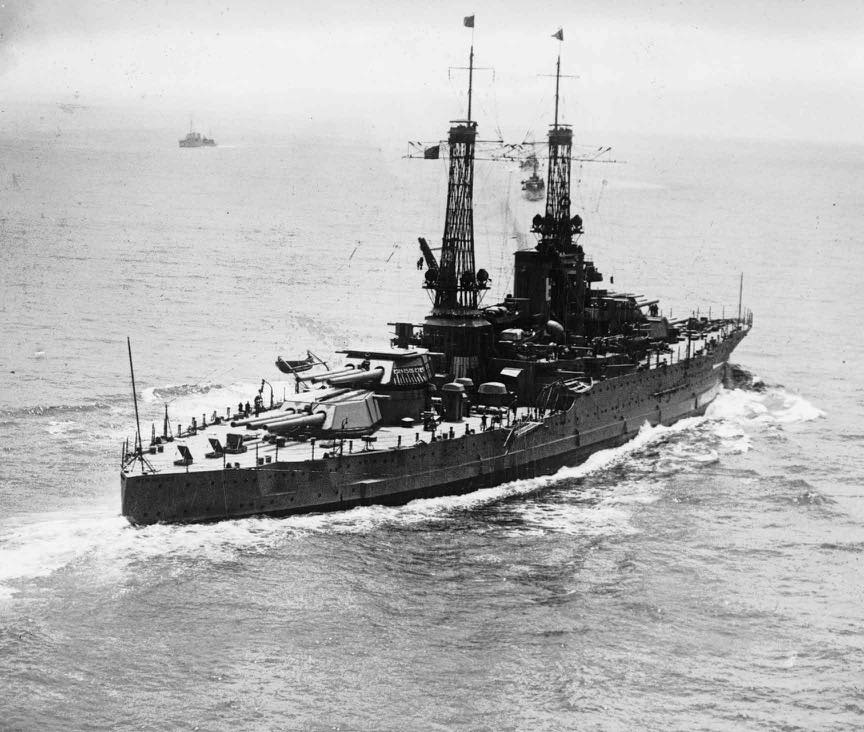USS New Mexico BB-40

USS New Mexico BB-40
.
(BB-40: dp. 32,000; l. 624'; b. 97'; dr. 30'; s. 21 k.; cpl. 1,084; a. 12 14", 14 5", 4 3", 2 21" tt.; cl. New Mexico)
The New Mexico (BB-40) was laid down on October 14, 1915, by the New York Navy Yard. Launched on April 13, 1917, she was sponsored by Miss Margaret C. DeBaca, daughter of the Governor of New Mexico, and commissioned on May 20, 1918, with Captain Ashley H. Robertson in command.
After initial training, New Mexico departed New York on January 15, 1919, for Brest, France, to escort the transport George Washington, carrying President Woodrow Wilson from the Versailles Peace Conference, returning to Hampton Roads on February 27. There, on July 16, she became the flagship of the newly-organized Pacific Fleet and three days later sailed for the Panama Canal and San Pedro, California, arriving on August 9. The next 12 years were marked by frequent combined maneuvers with the Atlantic Fleet in the Pacific and Caribbean, including visits to South American ports and a 1925 cruise to Australia and New Zealand.
Modernized and overhauled at Philadelphia between March 1931 and January 1933, New Mexico returned to the Pacific in October 1934 to resume training exercises and tactical development operations. As war loomed, she was based in Pearl Harbor from December 6, 1940, until May 20, 1941, when she sailed to join the Atlantic Fleet at Norfolk on June 16 for duty on neutrality patrol. After the Japanese attack on Pearl Harbor, she returned to the West Coast and sailed from San Francisco on August 1, 1942, to prepare in Hawaii for action. Between December 6, 1942, and March 22, 1943, she escorted troop transports to the Fijis, patrolled the Southwest Pacific, and returned to Pearl Harbor to prepare for the Aleutian campaign. Arriving in Adak on May 17, she served on the blockade of Attu and joined the massive bombardment of Kiska on July 21, forcing its evacuation a week later.
After refitting at Puget Sound Navy Yard, New Mexico returned to Pearl Harbor on October 25 to rehearse for the Gilbert Islands assault. During the invasion, which began on November 20, she bombarded Butaritari, guarded transports during their night withdrawals, and provided anti-aircraft cover during unloading operations, as well as screening carriers. She returned to Pearl Harbor on December 5.
Underway with the Marshall Islands assault force on January 12, 1944, New Mexico bombarded Kwajalein and Ebeye on January 31 and February 1, then replenished at Majuro. She blasted Wotje on February 20 and Kavieng, New Ireland, on March 20, then visited Sydney before arriving in the Solomons in May to rehearse for the Marianas operation.
New Mexico bombarded Tinian on June 14, Saipan on June 15, and Guam on June 16, and twice helped repel enemy air attacks on June 18. She protected transports off the Marianas while the carrier task force secured a major victory, the Battle of the Philippine Sea, on June 19-20. New Mexico escorted transports to Eniwetok, then sailed on July 9, guarding escort carriers until July 12, when her guns opened on Guam in preparation for the landings on July 21. She bombarded enemy positions and installations on the island until July 30.
After an overhaul at Bremerton from August to October, New Mexico arrived in Leyte Gulf on November 22 to cover the movement of reinforcement and supply convoys, firing in the almost daily air attacks over the Gulf, as the Japanese fiercely resisted the reconquest of the Philippines. She left Leyte Gulf on December 2 for the Palau Islands, where she joined a force covering the Mindoro-bound assault convoy. Again, she provided anti-aircraft cover as invasion troops stormed ashore on December 15, remaining for two days before sailing for the Palaus.
Her next operation was the invasion of Luzon, fought under skies filled with would-be suicide planes. She fired pre-landing bombardments on January 6, 1945, and sustained a suicide hit on her bridge that day, killing her commanding officer, Captain R. W. Fleming, and 29 others of her crew, with 87 injured. Her guns remained in action as she repaired damage, and she continued to support the landings on January 9.
After repairs at Pearl Harbor, New Mexico arrived at Ulithi to stage for the invasion of Okinawa, sailing on March 21 with a heavy fire support group. Her guns opened on Okinawa on March 26, and she continued supporting troops ashore until April 17. She resumed fire on April 21 and 29 and on May 11 destroyed eight suicide boats. On May 12, while approaching her berth in Hagushi anchorage, New Mexico was attacked by two kamikazes; one crashed into her, and the other hit her with a bomb. The attack killed 54 of her men and wounded 119. Swift action extinguished the fires within half an hour, and on May 28, she departed for repairs at Leyte, followed by rehearsals for the planned invasion of the Japanese home islands. She learned of the war's end at Saipan on August 15 and sailed for Okinawa the next day to join the occupation force. She entered Sagami Wan on August 27 to support the airborne occupation of Atsugi Airfield, then moved into Tokyo Bay on August 28 to witness the surrender on September 2.
New Mexico was homeward bound on September 6, calling at Okinawa, Pearl Harbor, and the Panama Canal before arriving in Boston on October 17. There, she was decommissioned on July 19, 1946, and sold for scrapping to Lipsett, Inc., New York City, on October 13, 1947.
New Mexico received six battle stars for her World War II service.
 >
>